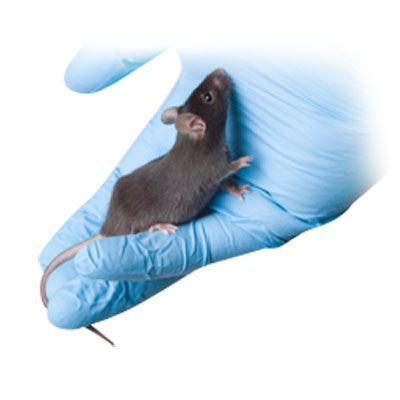Safety testing
New medicines or chemicals which may affect the health of humans are required by law to be tested on animals for safety.
While animal tests cannot predict all of the reactions a human may have to a new medicine, they can give us a lot of information to help prepare for the tests on people that will happen later on.
Safety testing begins early in the development of a potential drug, usually with acute toxicity tests where a single dose of the substance is given to an animal. Most safety testing is done using rodents, but before anything can be given to a human, it must be tested on a rodent and a non-rodent mammalian species.
Studies are designed so that the maximum information is obtained from the smallest number of animals. In the past, large numbers of animals were used to determine the lethal dose of a compound (the LD 50 test). This test is now rarely used, and toxicity studies are carried out on small groups of around three to five animals of each sex per dose. The non-rodent species groups are often smaller.
Acute toxicity testing
Safety tests begin with acute toxicity testing, where the animals are given a single dose of the test compound. These tests establish the range of doses, from the smallest amount that has any effect at all, to the amount that is life-threatening. The law recommends that effects on test animals should be compared with the effects on control groups of animals which have not received the compound.
Back to the topRepeat-dose toxicity testing
Repeat-dose testing explores how a compound acts on the body in more detail than the single acute-dose tests, using a different group of animals. The animals receive a series of doses over a period of time, which is more like the way medicines are usually taken. The organs that may suffer toxic effects, such as the liver, are examined and the safe starting dose for human clinical trials is estimated.
Back to the topLong-term toxicity testing
Longer toxicity studies are used to support and inform long-term clinical studies. They are used to review the suitability of species used for a particular medicine by comparing reactions in the animals and people over time. Better animal models are more accurate and lead to better outcomes for human patients.
Back to the topLate-stage toxicity testing
New medicines continue to be tested on animals throughout the clinical trial process, and the results of the human studies are used to inform and refine the animal studies so that they reveal more useful and accurate data. Later stage animal testing includes tests into the effects on fertility, and tests to see whether the substance may cause cancer. These tests help researchers to design and adapt the human clinical trials.
Back to the topNew developments
Alternative methods are increasingly being used to replace animals in safety testing, especially at the early acute dose stage.
Work funded through NC3Rs contributes to this. However, changes to safety requirements for environmental toxicology and general chemical testing within the EU (REACH) may mean that the number of animals used in safety testing will increase overall in the coming years.
Back to the topLast edited: 3 March 2021 12:25

